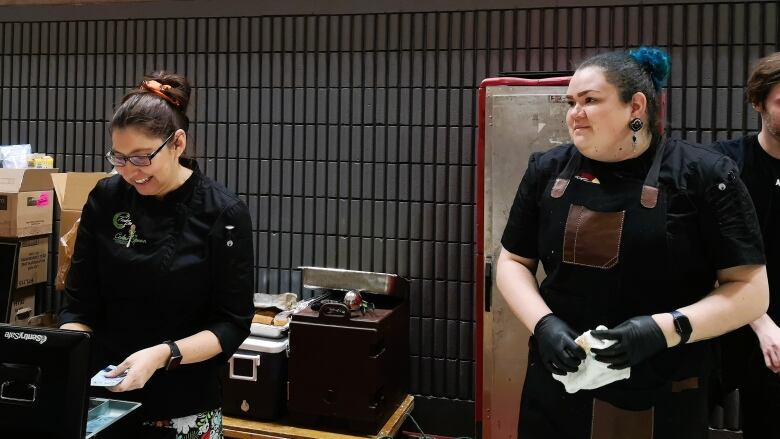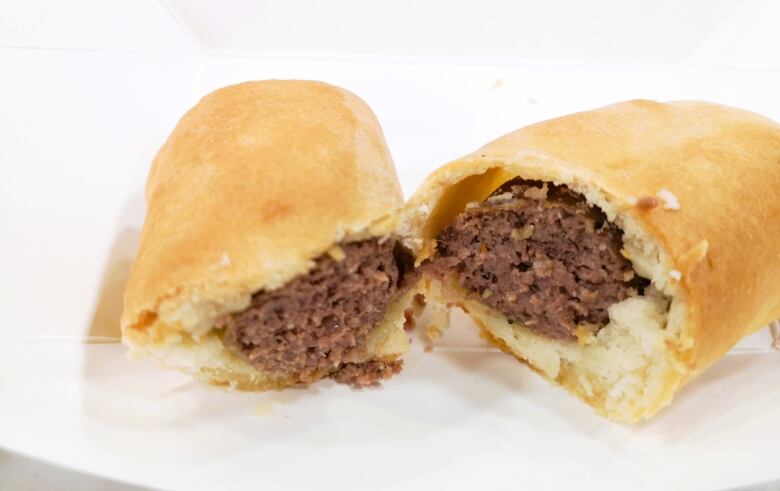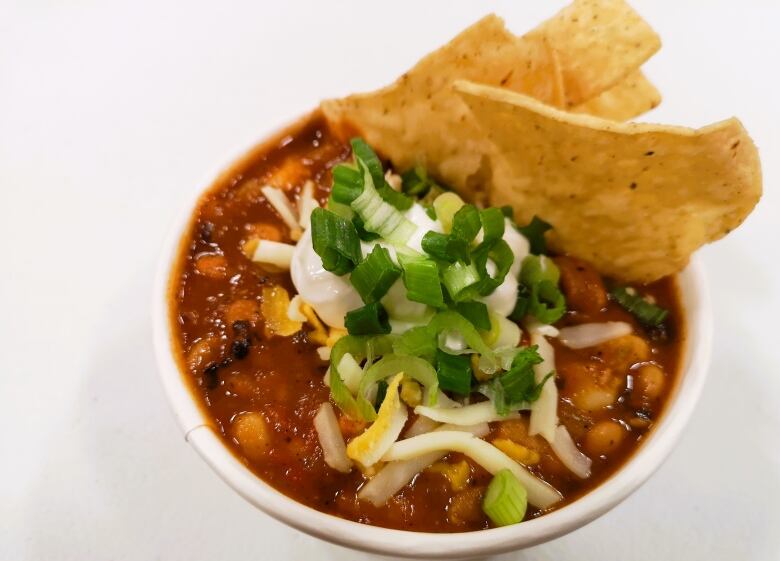Indigenous chefs serve up traditional fare at Conestoga College annual powwow
Event filled with traditional Indigenous singing, drumming, dancing and food

Amid beating drums, representing Mother Earth's heartbeat, and people dressed in traditional garments,like the iconic long ribbon skirts reaching to absorb earth's energy, aromas of food wafted through the field house of Conestoga College's Student Recreation Centre last weekend.
The 13thannual powwowdrew thousands of visitors to celebrate Indigenous culture, said Christina Restoule, manager of Indigenous Services at the Doon Campus.
"Be-Dah-Bin Gamik," which translates to "place of new beginnings," provides services to the College's Indigenous students, including status and non-status First Nations, Mtis and Inuit.
"2020 was our last in-person powwow. The last two years were virtual, but that can't capture the energy of the live event. This year, we were happy that about 5,000 people came through our doors," she said.
Passing the sacred fire burning in a brazier in an open area just outside therecreation centre, visitors wandered among artwork, crafts, vendors' boothsand children's activities,and nursing centres, while traditional singing and dancing took place around them.

"We had drummers and dancers from far and wide," Restoule said, noting the broad geographic reachthe event had.
'We choose local when we can'
In any celebration and in any culturefood plays a key role.
At the powwow, chefs Destiny Moser of Cedar Spoon Indigenous Catering and Sydney Keedwell of White Owl Native Ancestry Association collaborated to create Aandanjige Caf,which translates roughly to "way of eating" in Ojibwe.
Other food vendors included Nancy Laughing-Papineau, owner of Eleven Eighty Catering, and Rick Antone of Two Turtles
They prepared a couple of simple dishesweighted with cultural significance.

"Sydney and I got together and made bison sausage wrapped in bannock and a vegetarian, gluten-free Three Sisters chili," said Moser who was born in Waterloo and is part of the Ojibwe tribe of the Rainy River Band.
In adding onions, tomatoes and peppers to the chili, Moser pointedout how Indigenous culture faced the arrival of European culture.
"That food would have come with the settlers," she said.
Kitchener-born Keedwell explained the ingredients they used came from local producers, including Stevanus Family Farm, Fat Sparrow and Oakridge Acres.
The dearth of wintertime produce notwithstanding, she said cooking is more than just collecting the ingredients on a shopping list.
"We choose local when we canand we have really great relationships (with suppliers) and great allies," she said.

Formerly a chef at Waterloo's Taco Farm, Keedwell continues to learn about her heritage, tracing her mother's Indigenous roots toEspanola, Ont.
"We always attended pow wows as kids, but it's nice to re-connect with the community and use food to bond and learn," she said.
Paying homage to Mother Earth through food
For both cooks, the food of their culture is situated within the larger context of Turtle Island.
"We don't believe in waste. We shouldn't over-indulgeand we need the animals and the plants. As we prepare these meals, however, we want to make sure we're giving gratitude to Mother Earth for allowing us to have this food," said Moser.
The Three Sisters squash, beans and maize or corn exemplify farming and horticultural ingenuity through the interconnection of what have been primary crops for Indigenous peoples in North America.
A marvellous example of agrarian symbiosis, corn and beans are planted in small mounds of earth, along with squash.
The cornstalk, stabilized by the mounds, becomes a "trellis" for the climbing beans, which, chemically, fix nitrogen in the soil while the squash plants' large leaves shade the ground and retain moisture.
Bannock, similarly, has an importantbut darker history.

Believed to have been prepared by 18th-century Scottish fur traders who made a quick bread on a "bannock stone" in a firepit, Indigenous peopleeventually adopted bannock and often used plants or corn for flour rather than wheat, which did not originate in North America.
Keedwell noted that Indigenous peoplecooked bannock for survival when they were moved off the land. Unable to hunt, they started making bannock to sustain themselves.
"I try to keep in mind that although bannock is culturally significant for us, it has come out of colonialism. It was a food of survival on reservations, and for us it is really important," she said.
Moser estimates the pop-up caf served about 1,000 portions of food at the powwow. In doing so, for many customers, Indigenous food like bannock and bison, an animal Indigenous to Canada, and the Three Sisters presented themselves as iconic cultural artifacts serving an educational purpose as well as tasting delicious.
"We don't need to teach people about being Indigenous," Moser said. "But we really want to showcase the Indigenous foods of Canada that are here in our backyard."
Sydney Keedwell's Three Sistersvegetarian chili

Ingredients
- 2 stalks of celery, diced.
- 2 Spanish onion, diced.
- 3 cloves of garlic, chopped or minced.
- 1 jalapeo pepper, small dice (optional: remove seeds).
- 1 small can of tomato paste.
- 1 large can of fire roasted diced tomatoes.
- 1 butternut squash, diced and seeds removed.
- 1 bunch of cilantro, chopped.
- 1 to 2 carrots, diced.
- 2 to 3 tablespoons Canola oil.
- 1 25-ounce can of hominy, drained and rinsed.
- 2 tablespoons of apple cider vinegar.
- 1 lime.
- 3 540ml cans of beans (any type), drained and rinsed.
- Salt and pepper to taste.
- 1 tablespoon Mexican oregano.
- 2 teaspoon cumin.
- 1 tablespoon ancho powder.
- 1 tablespoon morita powder.
- 1 tablespoon Mexican chili powder.
- 1 tablespoon paprika.
- 1 to 2 cups of vegetable stalk or water.
Optional ingredients and toppings:
- Maple syrup.
- Crema.
- Cheese.
- Chips.
- Green onions.
- Meat or meat substitute.
Method
Wash and pre-chop ingredients before starting to cook.
Warm a large pot on the stove, medium high. When it's hot, add the oil. If you are unsure the pan should sizzle before adding the veggies.
Add onions, celery, carrots, squash and jalapeo. Cook on medium high heat until the vegetables start to brown slightly, about five minutes.
Add spices including salt and pepper. Add tomato paste and stir thoroughly. Cook until fragrant, and coated in oil. Add ground meat if you choose.
Next add juice of onelime and apple cider vinegar. Gently scrape the bottom of the pot to get all the brown bits off. Add diced tomatoes. Add about onecup of vegetable stalk or water (more can be added later, if needed. Add rinsed beans and hominy and half of the cilantro.
Lower the heat. Three Sisters chili is best cooked over one to four hours on low heat. Stir often and add water if needed. Half-way through your cooking time, taste and adjust seasoning as needed.
Optional: add maple syrup, about two tablespoons.
When all the vegetables are tender and the chili is thick and flavourful, you are ready to serve. Add toppings like the chopped cilantro, crema, cheese and tortilla chips.
Enjoy!












_(720p).jpg)


 OFFICIAL HD MUSIC VIDEO.jpg)
.jpg)



























































































